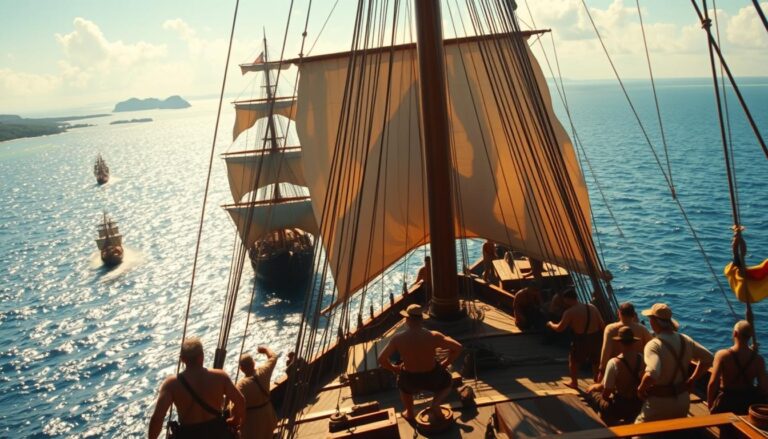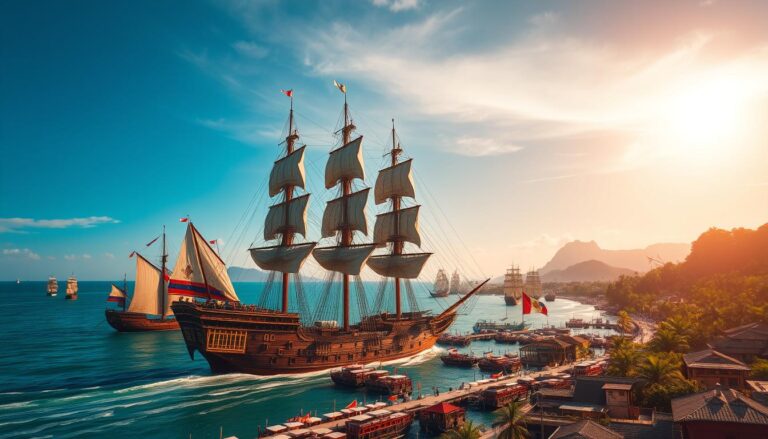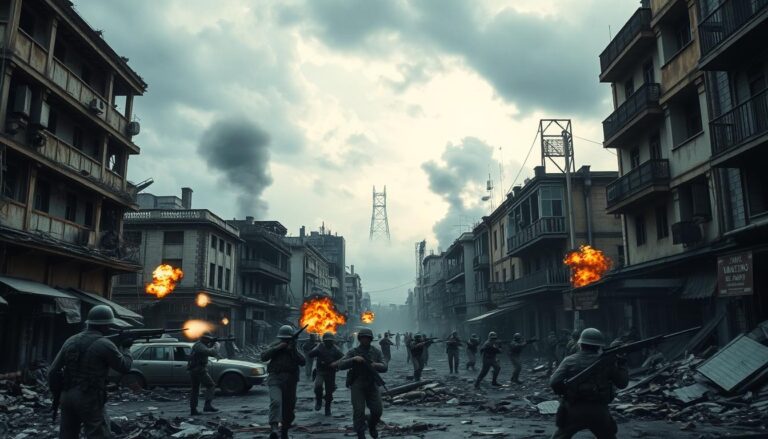Jose Rizal: Philippine National Hero and Visionary
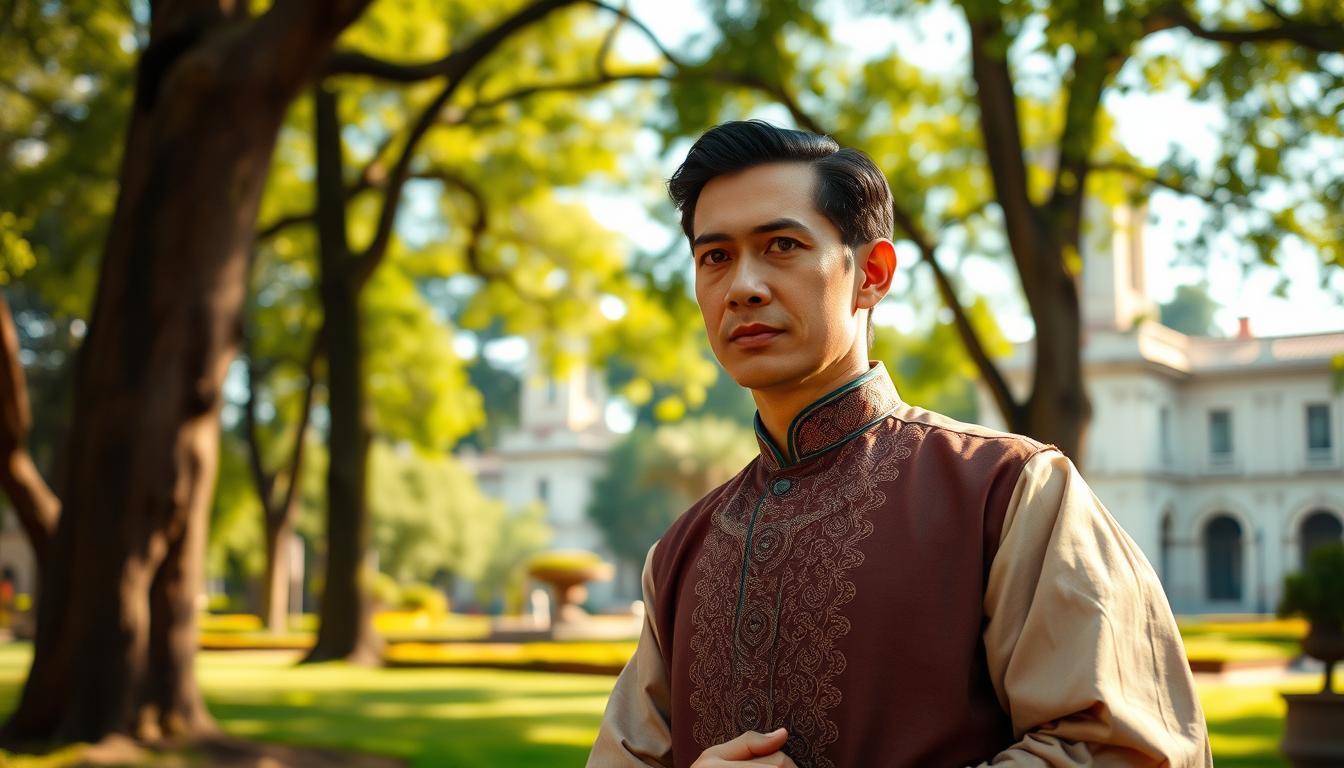
Did you know Jose Rizal, the Philippine national hero, was born on June 19, 1861? He was the seventh of eleven children in a wealthy family. His family’s wealth gave him a good education, which sparked his desire for change and unity.
As a Filipino nationalist, Rizal’s impact goes beyond his books. His legacy still inspires talks about freedom and identity today. We will delve into Jose Rizal’s life, his early years, and how his writings continue to shape the Philippines and the world.
Key Takeaways
- Jose Rizal was born on June 19, 1861, and became a prominent Filipino nationalist.
- He excelled academically, earning a Bachelor of Arts degree with highest honors.
- Rizal published influential novels that criticized Spanish colonial rule.
- His execution in 1896 sparked a wave of nationalism among Filipinos.
- Rizal founded La Liga Filipina to advocate for peaceful reforms.
- His legacy continues to be celebrated in literature and national identity in the Philippines.
Introduction to Jose Rizal: The Visionary
Jose Rizal is a key figure in Philippine history, symbolizing Filipino nationalism. He was born on June 19, 1861, in Calamba, Laguna, under Spanish rule. At nine, he started at the Ateneo Municipal de Manila, setting the stage for his intellectual growth.
He excelled in his studies, earning his Bachelor of Arts with honors. This achievement was a milestone in his life.
Rizal’s writings, like “Noli Me Tangere” and “El Filibusterismo,” are vital to understanding his vision. Published in 1886 and 1891, these novels criticized the injustices faced by Filipinos. His work inspired many to challenge the colonial system, sparking resistance among Filipinos.
Rizal believed education was crucial for change. He thought knowledge and enlightenment were vital for independence. His writings sparked a desire for freedom and a roadmap to a fair society.
Rizal’s life was tragically cut short when he was executed on December 30, 1896, in Luneta, Manila. Yet, his legacy lives on, inspiring people to fight for their rights and national identity. His commitment to nonviolent resistance and intellectual rigor makes him a lasting symbol of hope for the Philippines.
Early Life of Jose Rizal
Jose Rizal’s early life shows how his background shaped him. Born in Calamba, Laguna, he grew up with a love for learning. His early years set the stage for his fight for change in the Philippines.
Birth and Family Background
Jose Rizal was born on June 19, 1861, to a big family. His parents, Francisco and Teodora, taught him the importance of family and country. Growing up with eleven siblings, Rizal learned the value of family and education.
Education and Early Interests
Rizal showed his smarts early. By five, he could read and write. He went to school in Calamba and later at the Ateneo Municipal de Manila.
There, he graduated with honors. His love for poetry and languages grew. He mastered nearly 22 languages and wrote his first poem, “Sa Aking Mga Kababata,” at eight. This marked the start of his literary career.
The Becoming of a Filipino Nationalist
Jose Rizal’s journey to becoming a key figure in Filipino nationalism started in Europe. There, he saw many social injustices, which sparked his desire to make a change. He joined the Propaganda Movement to fight against the colonial government’s oppression.
His writings, like Noli Me Tangere in 1887, were powerful tools for expressing Filipino frustrations. They showed the harsh realities under Spanish rule. Rizal’s second novel, El Filibusterismo, in 1891, further solidified his stance for change.
These works challenged the status quo and inspired many Filipinos to find their national identity. Despite criticism, Rizal’s dedication to education and reform guided his people.
Today, Filipino nationalism faces new challenges. Many young Filipinos lack knowledge of their history, unlike previous generations. Rizal believed history builds national consciousness. Yet, modern education often focuses on superficial loyalty rather than deep historical analysis.
Jose Rizal’s legacy is crucial for understanding Filipino nationalism. His sacrifices and those of early nationalists are vital to appreciate. Claro M. Recto said knowing history is key to embracing nationalist values and unity.
This understanding is essential for a strong and unified national consciousness. It’s vital for the Philippines’ future progress.
Jose Rizal’s Literary Contributions
Jose Rizal’s works are key to understanding the Philippines’ fight for freedom. His novels highlighted social wrongs and motivated people to demand change. His two main novels, Noli Me Tangere and El Filibusterismo, show his dream of a better society.
Noli Me Tangere: A Revolutionary Novel
Published in 1887, Noli Me Tangere was a strong attack on Spanish rule and the Catholic Church’s wrongdoings. It tells the story of Crisostomo Ibarra, a Filipino who comes home to face the tough realities of his people. Rizal’s detailed portrayal of corruption and social problems sparked important discussions and led to the book being banned in the Philippines. This novel was a key factor in waking up society and fueling the fight for independence.
El Filibusterismo: The Sequel and Its Impact
In 1891, Rizal published El Filibusterismo, the follow-up to Noli Me Tangere. This book delved deeper into the problems faced by Filipinos, stressing the need for big changes. The story is darker, showing the frustration of its hero with the current state of things. Rizal dedicated this work to the GOMBURZA, three priests who were killed for pushing for reform, showing the price of fighting for justice. Both novels made Rizal a literary star and a symbol of revolution.

| Title | Publication Year | Main Theme | Significance |
|---|---|---|---|
| Noli Me Tangere | 1887 | Social injustice and corruption | First major work that incited public awareness against colonial rule |
| El Filibusterismo | 1891 | Radical reform and resistance | Continued the narrative, emphasizing the need for action against oppression |
Rizal and the Propaganda Movement
Jose Rizal became a key figure in the Propaganda Movement of the 1880s in the Philippines. This movement aimed to make the Philippines an autonomous province of Spain. It fought for basic civil rights in the Philippines.
Rizal worked with other thinkers in Europe to push for big changes. Together, they used their voices to demand important reforms.
In 1887, Rizal wrote Noli Me Tangere, a strong attack on Spanish rule and church corruption. This book sparked public outrage and made Rizal a leading voice in the Propaganda Movement. His work grew to include 25 volumes, covering poetry, drawings, and documents about Filipino struggles.
Rizal saw himself as a true Filipino, not just a part of Spain’s empire. His research in the British Library in 1889 gave him deep insights. He wanted to raise the Filipino voice worldwide.
Despite his efforts, Rizal was executed on December 30, 1896, for rebellion and conspiracy. His death sparked a surge in national pride. It showed the Propaganda Movement’s role in fighting for Philippine freedom.
On June 12, 1898, the Philippines gained independence from Spain. This victory honored Rizal’s legacy and the movement’s fight for freedom.
The Legacy of Jose Rizal in Philippine Literature
Jose Rizal’s writings have deeply shaped Philippine literature. His works reflect the society of his time and inspire change. They also highlight the importance of national identity.
Influence on Modern Filipino Writers
Rizal’s novels, Noli Me Tángere and El Filibusterismo, are key in Philippine literature. They address important social issues and motivate others to write about injustice and identity. Rizal’s stories have become a source of inspiration for many writers.
Today, many authors are influenced by Rizal’s work. His focus on education and empowerment is seen in their writing. This creates a sense of pride in Filipino culture. Rizal’s emphasis on social justice inspires writers to tackle complex issues.
- Rizal’s exploration of social issues remains relevant in today’s literary landscape.
- His legacy encourages writers to address nationalism and cultural identity.
- Filipino writers honor Rizal by showcasing their cultural heritage through their work.
Rizal’s Vision for the Philippines
Jose Rizal dreamed of a Philippines that was enlightened and free. He believed in the power of education and reform for progress. His essay “The Philippines A Century Hence,” written in 1889, was published in La Solidaridad. It shows his vision for the country’s future under foreign rule.
Rizal thought that if Spain didn’t listen to Filipino concerns, America might step in. He highlighted the need for change after thirty years of Spanish rule. He saw education as key for Filipinos to learn and lead themselves, pushing for reforms.
Rizal’s ideas were shaped by enlightenment and thinkers like Feodor Jagor. He believed in a cultural and social awakening led by the young. He wanted a Philippines free from colonial rule, where people had their rights and freedoms.
He also understood global issues like peak oil and climate change. Rizal envisioned a future with new foreign powers but still wanted a sovereign Philippines. He even suggested a federal republic if the country gained freedom.
Rizal’s vision was rooted in his commitment to social justice and equality. He hoped for a future where education and reform were key to the Philippines’ success.
The Martyrdom of Jose Rizal
Jose Rizal’s death on December 30, 1896, changed Philippine history. His execution sparked a strong wish for freedom among Filipinos. They saw him as a hero.
He was charged with sedition and faced a trial. The prosecution used many exhibits and testimonies against him. Yet, he remained calm, knowing the possible penalties.
In his last moments, Rizal asked to be shot in the back, not the head. He was executed at Babumbayan field by eight native soldiers. Before his death, he wrote a letter to Ferdinand Blumentritt and his famous poem, “Mi Ultimo Adios.”
After his death, Rizal’s body was secretly buried at Paco Cemetery. His sister, Narcisa, later found his grave and marked it with his initials. The Rizal family kept his letters and books alive, honoring his legacy.
Rizal’s sacrifice continues to inspire today. It reminds us of his role as a national hero. It encourages us to fight for freedom and justice.

Rizal Park and Its Significance
Rizal Park, also known as Luneta Park, is a major tribute in Manila to Jose Rizal, the Filipino national hero. It covers an impressive 58 hectares (140 acres). The park is home to 3,497 trees and over 112 species of plants, showing its ecological richness.
The Rizal Monument is the park’s centerpiece. It was unveiled on December 30, 1913. This bronze sculpture symbolizes Filipino nationalism and the sacrifices for independence. In 1955, it was declared a national park, boosting its cultural and historical importance.
Kilometer Zero is a key attraction, marking the start of all distances in the Philippines. Next to the Rizal Monument is the National Museum Complex. It includes the National Museum of Fine Arts and the National Museum of Anthropology.
The Japanese Garden and the Chinese Garden offer peaceful spots. They were gifts from Japan and China. The park is a place for fun and also hosts big events like the Philippine Independence Day.
In 2011, the park got a makeover to keep its history alive. The Children’s Playground and the Open-Air Auditorium are great for families and culture lovers. Despite challenges, the park is still a favorite for its mix of history, nature, and fun.
Rizal Park’s legacy is deep, capturing the nation’s spirit. It helps us understand Jose Rizal’s vision and his role in Filipino identity.
The Rizal Monument: A National Tribute
The Rizal Monument stands tall in Luneta Park, honoring Jose Rizal’s legacy. It’s not just a work of art but also a symbol of national pride. Built between 1908 and 1913, it stands 12.7 meters high and was dedicated on December 30, 1913, to remember Rizal’s sacrifice.
Italian architect Carlo Nicoli designed the monument. It features a bronze statue of Rizal holding his famous novels, “Noli Me Tangere” and “El Filibusterismo”. It reminds us of his contributions and ideals that inspire many Filipinos. It was declared a National Historical Landmark on April 15, 2013, highlighting its importance.
The construction cost was initially estimated at ₱100,000. But by August 1912, funds reached ₱135,195.61. In 1961, it was remodeled, increasing its height to 30.5 meters. This change made it more visible and impressive. Today, the Rizal Monument is a key part of Filipino culture and history, attracting visitors from everywhere.
| Detail | Information |
|---|---|
| Coordinates | 14°34′54″N 120°58′36″E |
| Original Height | 12.7 meters (42 ft) |
| Construction Period | 1908-1913 |
| Dedication Date | December 30, 1913 |
| National Historical Landmark Designation | April 15, 2013 |
| Design Competition Period | 1905-1907 |
| Initial Estimated Cost | ₱100,000 |
| Funds Raised by August 1912 | ₱135,195.61 |
| Winning Designer | Carlo Nicoli |
| Sculptor | Richard Kissling |
| Remodeled Height | 30.5 meters |
| Significance of December 30 | Declared a national day of mourning in 1898 |
| Luneta Designation | September 28, 1901 |
Rizal’s Ideas and Their Modern Relevance
Jose Rizal’s ideas still echo in today’s Philippines. He stressed the importance of education, social justice, and national identity. These themes are still debated today, showing Rizal’s lasting impact.
Quino de Jesus, a 4th-year student at Ateneo, connects Rizal’s legacy to today’s youth. His essay, “Rizal na, Europa Pa,” won a grand prize. It shows how Rizal’s diverse talents inspire young Filipinos.
The love for literature among Filipino youth also shows Rizal’s lasting influence. Quino’s success in writing contests reflects Rizal’s love for artistic expression. This love for culture is growing, thanks to Rizal’s efforts.
Young leaders like Quino are exploring Philippine heritage. This is similar to Rizal’s experiences in Europe. These experiences shaped Rizal and continue to shape today’s Filipino society.
| Jose Rizal’s Ideals | Modern Application |
|---|---|
| Education as a Solution to Social Issues | Advocacy for Educational Reforms |
| Promotion of Filipino Identity | Revival of Cultural Heritage |
| Advocacy for Social Justice | Support for Equal Rights Movements |
| Diverse Talents and Contributions | Encouragement of Artistic Expression |
Rizal’s ideas continue to inspire today’s believers in progress. They help build a society that faces challenges head-on. This society is committed to freedom and equality.
Global Recognition of Jose Rizal
Jose Rizal’s work in literature and his fight for freedom have made him famous worldwide. His ideas about education and unity still inspire people everywhere. Countries honor him with memorials, showing his role as a symbol against oppression.
Memorials and Honors Around the World
In many countries, you can find memorials to Jose Rizal. The United States, Spain, and Latin America have statues, parks, and schools named after him. These places are more than just tributes; they stand for Rizal’s fight for freedom and knowledge.
| Country | Type of Memorial | Location |
|---|---|---|
| United States | Statue | Seattle, Washington |
| Spain | Park | Madrid |
| Mexico | Commemorative Plaque | Mexico City |
| Philippines | National Park | Manila |
| Argentina | Cultural Center | Buenos Aires |
These memorials celebrate Jose Rizal’s legacy and his dream of a world without discrimination. His emphasis on education and respecting others’ beliefs motivates many. Through these memorials, Rizal’s influence on the world is clear.
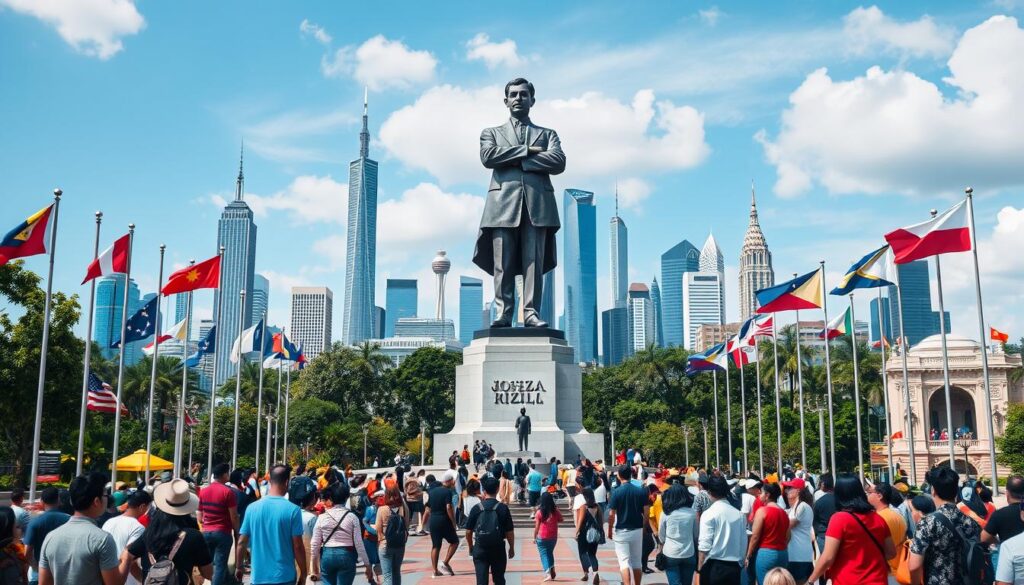
The Influence of Jose Rizal on National Identity
Jose Rizal has greatly shaped the Philippines’ national identity. His writings and ideas brought Filipinos together, despite their differences. This unity is based on shared goals, like freedom and self-rule.
Rizal criticized colonial rule, encouraging Filipinos to embrace their heritage. His books, Noli Me Tangere and El Filibusterismo, sparked a national spirit. He is celebrated as “the first Filipino” for inspiring pride in a diverse people.
Rizal’s writings have shaped the Philippines’ national identity. He inspired others, like Sultan Kudarat and Emilio Aguinaldo, to fight for freedom. Rizal stands as a symbol of patriotism and civic duty.
Rizal’s legacy is felt across Luzon, Visayas, and Mindanao. His execution in 1896 was a turning point in the fight for independence. Today, Rizal’s legacy unites Filipinos, fostering pride in their shared heritage.
| Key Figures | Contribution to National Identity |
|---|---|
| Jose Rizal | Father of Filipino Nationalism; wrote novels critiquing colonialism |
| Sultan Kudarat | Defended Muslim sovereignty against Spanish forces |
| Emilio Aguinaldo | Leader in the struggle for independence against U.S. colonization |
Contemporary Perspectives on Jose Rizal
Today, people have mixed feelings about Jose Rizal. Some admire his writing and his role in Philippine history. Others question his methods and beliefs. His life and work help us see the effects of colonialism on our society today.
There’s a growing debate about Rizal’s place in today’s world. Schools say we need to look at his work from different angles. This includes his fight for national identity and his support for human rights, which are still important today.
The Development Academy of the Philippines is key in teaching about the future. They work with schools to make sure Rizal’s ideas are part of today’s education. Events like those sponsored by the Asian Development Bank show how Rizal’s ideas match our goals for the future.
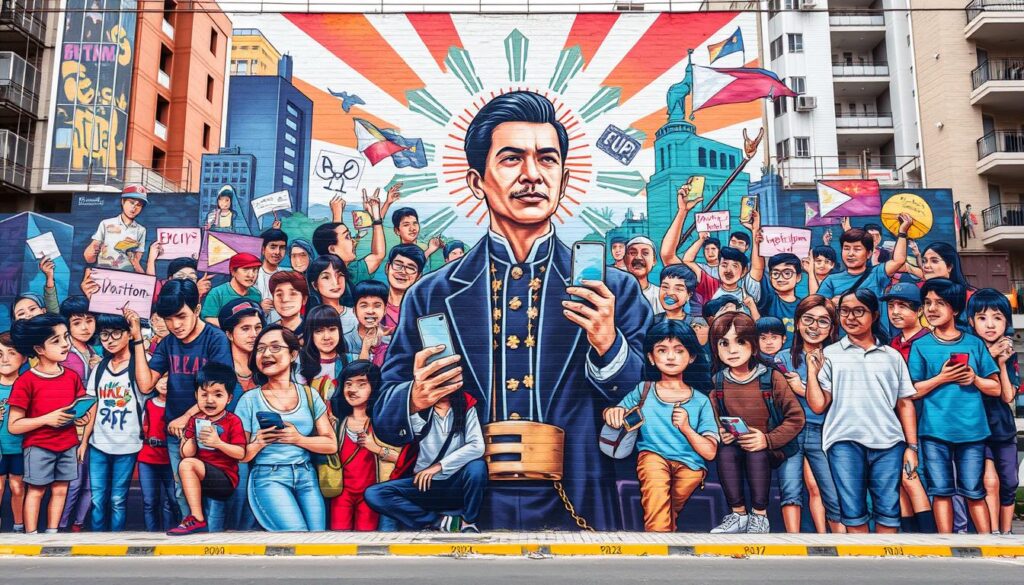
| Event | Date | Significance |
|---|---|---|
| First Philippine Futuristics Conference | 1980 | Set the stage for discussions on Rizal’s foresight. |
| First Philippine Futures Day: Paglalayag Tungo sa Hiraya | June 19, 2021 | Celebrated Rizal’s ongoing relevance. |
Rizal’s legacy goes beyond just being remembered. His books, “Noli Me Tangere” and “El Filibusterismo,” show he was a visionary. He spoke out against unfair systems, which is still important today. His ideas continue to shape our understanding of the Philippines and its future.
Education and Awareness of Rizal’s Contributions
Learning about Jose Rizal is key in Philippine schools. Students study his novels, Noli Me Tangere and El Filibusterismo. These works talk about fighting against unfair rules and seeking change.
These books show Rizal’s talent and spark talks on being proud of one’s country and doing the right thing.
Schools worldwide teach about Rizal’s role in creating a society that cares. They focus on his ideas of justice, fairness, and national pride. This helps students see how his work is still important today.
Teachers use fun ways to teach about Rizal. They have interactive lessons, community events, and cultural activities. These help students feel proud of their heritage and learn about Rizal’s values.
| Year | Event | Significance |
|---|---|---|
| 1861 | Birth of José Rizal | Birth of a national hero who would inspire generations. |
| 1887 | Publication of Noli Me Tangere | Highlighted Spanish colonial abuses and sparked reform movements. |
| 1891 | Publication of El Filibusterismo | Solidified Rizal’s influence in the push for Philippine independence. |
| 1892 | Founding of Liga Filipina | Aimed at peaceful reform and engagement in the national cause. |
| 1896 | Execution of José Rizal | Martyrdom cemented his legacy as a symbol of the fight for freedom. |
Rizal’s impact is still felt today. It leads to talks about Filipino culture and keeping national identity strong through education. By learning about him, you join a bigger conversation on freedom, rights, and civic duty.
Conclusion
The Jose Rizal legacy shows the lasting power of ideas and a nation’s spirit. His works, like “Noli Me Tangere” and “El Filibusterismo,” reflect and drive change. They highlight the need for education and justice.
Rizal’s life and death sparked a national movement. His ideas of freedom and education are key to Philippine culture. He stands as a beacon of hope for future generations.
Jose Rizal’s legacy is crucial for understanding the Philippines. It encourages embracing your roots and identity. His vision for a united, educated nation continues to inspire today.

